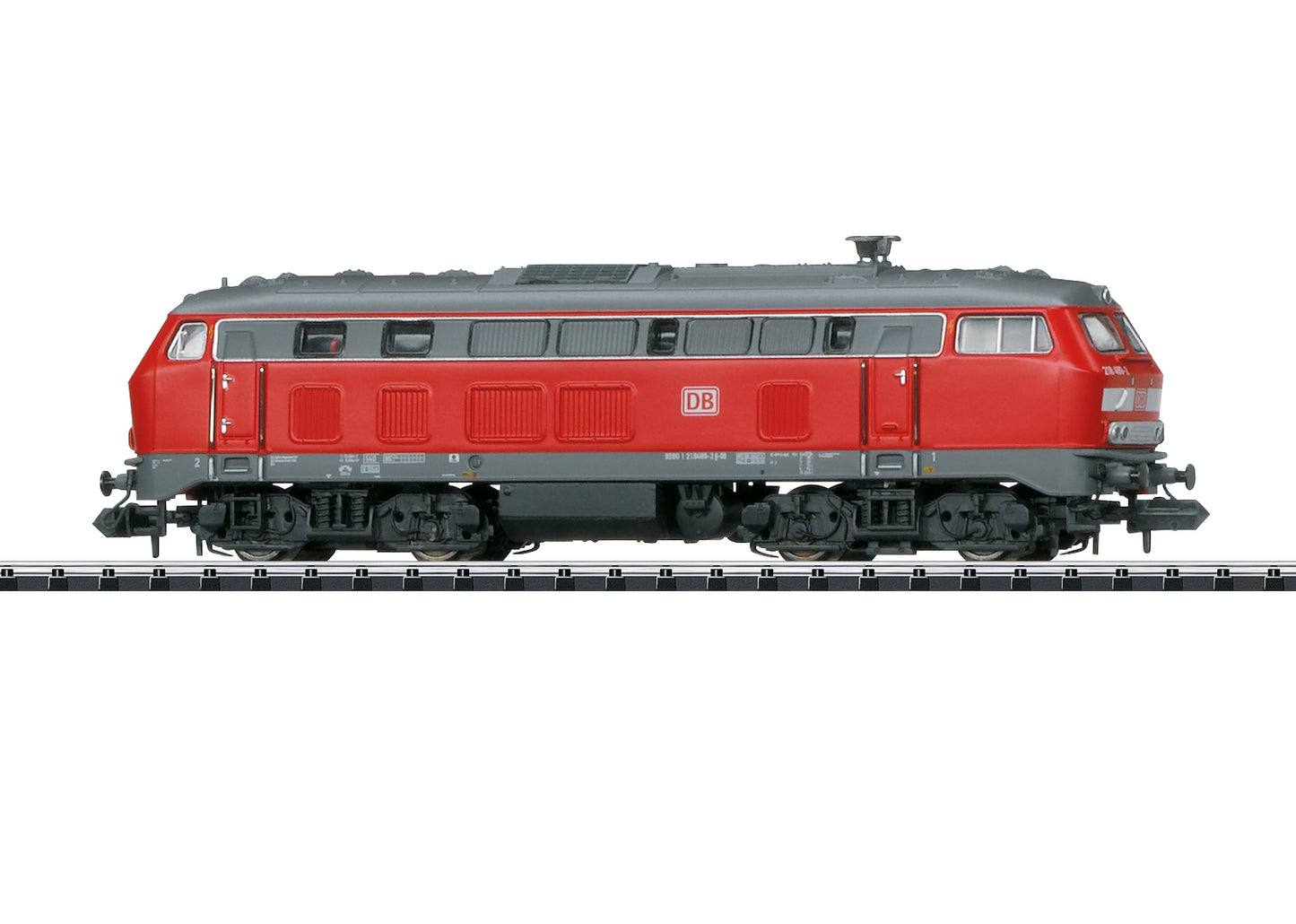Trix 16823 - Class 218 Diesel Locomotive
Prototype: German Railroad, Inc. (DB AG) general-purpose locomotive, road number 218 425-7, DB Regio Bayern Kempten. Diesel hydraulic locomotive with roof version to accommodate the MTU 12V 956 TB 11 motor. With parallel exhaust hoods and Behr cooling equipment in a V shape.
Highlights
- Digital sound with many functions.
Product description
Model: The locomotive has a built-in digital decoder and sound generator for operation with mfx and DCC. The motor includes a flywheel. 4 axles powered. Traction tires. The headlights and marker lights change over with the direction of travel. Warm white LEDs are used for the lighting. The cabs have lighting that can be controlled digitally. The locomotive has a close coupler mechanism. The headlights and marker lights change over with the direction of travel in digital and analog operation. The locomotive has separately applied grab irons. Length over the buffers 102 mm / 4".
Publications
- New items brochure Minitrix 2021 - Main Catalog Minitrix 2021/2022 - Main Catalog Minitrix 2022/2023 - New items brochure Minitrix 2025Prototype information
Over the past 40 years, the class 218 has left its mark on the image of the DB like no other diesel locomotive, with the exception of electrified main lines. Double-headed pulling heavy InterCity trains in the Allgäu and on the Marsch line or in regional service pulling shuttle trains – the class 218 units defined to a large extent the image of hauling trains with diesel locomotives. The class 218 locomotives represented the end of the development of the "V 160 Family". With them, steam heating could be replaced with electric heating with no problem. After the development of a diesel motor with a performance of 2,500 horsepower (1,839 kilowatts), the generator could be used to power both the traction motor and the electric heating, which made an auxiliary diesel motor superfluous. In 1968/69, the DB purchased an initial 12 test locomotives, road numbers 218 001-012, from Krupp with the new motor. After a successful probationary period, the 398 regular production units followed starting in the spring of 1971 as road numbers 218 101-398 and 400-499, with construction by Krauss-Maffei and Rheinstahl-Henschel in addition to Krupp. Road number 218 399 previously not rostered formed a "lateral entrant", because it was road number 215 112 involved in 1975 in an accident, which was restored with electric heating and then rostered as road number 218 399. Naturally, numerous detail improvements were done on the series during the procurement period. Initially, only the 2,500 horsepower motor was installed. The later production runs, over half of the units, were given a more powerful motor with 2,800 horsepower (2,059 kilowatts) performance. Initially, only German motors from MTU were installed, later also motors from the French manufacturer SEMT Pielstick (licensed production KHD). Starting in 1981, exhaust hoods were added on the roof to direct exhaust gas away from catenary and to minimize exhaust gas affecting passengers. Here hoods arranged next to one another identified the MTU twelve-cylinder motors (TB10/TB11), and diagonally arranged hoods identified the sixteen-cylinder motors (Pielstick, MTU 4000). In recent years, their ranks have thinned out considerably. With a service age of at least 40 years, many units, mostly the older production series, have since been retired. Uses worthy of mention are the bases of Niebüll, Mühldorf, Kempten, and Ulm. Road number 218 499 has been based at the last location since December of 2008. It came to the DB in June of 1979 and is thereby the last large diesel locomotive purchased by the German Federal Railroad at all. As with its sibling units of the last series (road numbers 218 485-498), a Pielstick diesel motor, type "16 PA4 V 200", was initially installed in it and around 1985 diagonally arranged hoods were added. In the course of an overhaul in 1995, the Pielstick motor was replaced by an MTU motor of the same power (12V 956 TB 11) now with two exhaust hoods arranged in parallel. Here it kept its V-shaped Behr cooling equipment, which is recognizable by the large mesh grill on the roof. Tour de force performances by the Ulm units and thereby also road number 218 499 have been in part up to the present the Intercity train pairs IC 2012/2013 "Allgäu" between Stuttgart and Oberstdorf, IC 2084/2085 "Nebelhorn" between Augsburg and Oberstdorf, as well as occasionally IC 118/119 between (Stuttgart) Ulm and Lindau.
Features
Warning
| DCC | SX2 | SX | MFX | |
|---|---|---|---|---|
| Headlight(s) | X | X | ||
| High Pitch Horn | X | X | ||
| Diesel locomotive op. sounds | X | X | ||
| Engineer’s cab lighting | X | X | ||
| Direct control | X | X | ||
| Sound of squealing brakes off | X | X | ||
| Rear Headlights off | X | X | ||
| Low Pitch Horn | X | X | ||
| Front Headlights off | X | X | ||
| Station Announcements | X | X | ||
| Conductor's Whistle | X | X | ||
| Brake Compressor | X | X | ||
| Blower motors | X | X | ||
| Letting off Air | X | X | ||
| Horn | X | X | ||
| Special sound function | X | X | ||
| Train announcement | X | X | ||
| Doors Closing | X | X | ||
| Special sound function | X | X | ||
| Replenishing fuel | X | X | ||
| SIFA warning sound | X | X | ||
| Sanding | X | X | ||
| Doors Closing | X | X | ||
| Station Announcements | X | X | ||
| Train announcement | X | X | ||
| Train announcement | X | X |
EAN/UPC: 4028106000003



